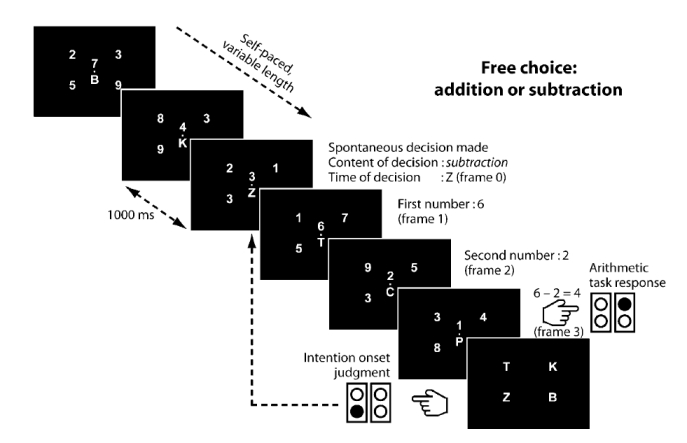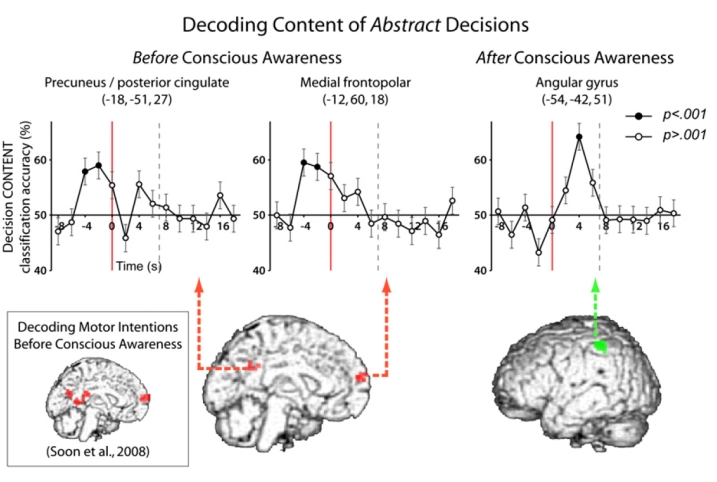This is a superb article from Jerry Coyne over at Why Evolution Is True about the work being done building on and improving upon the Benjamin Libet experiments which I have talked about before online and in my book. Thanks you so much to Jerry who has allowed me to repost his article. Please, please check out his excellent blog.
This is of particular importance because a YEC theistic commenter and apparent libertarian free willer, JohnM, has been arguing his case about alternate possibilities, right up until changing his mind on reading a piece by the Information Philosopher. The problem is, his model does not allow for LFW or alternate possibilities in the way JohnM was arguing. But that’s another story. What this post is about is saying, well, if you don’t quite get how alternate possibilities is incoherent, then let’s look at actual empirical evidence to point to the notion that conscious will is illusory, epiphenomenal or some such similar idea. The idea is that if our brain is missing a vital piece of intention, it invents it. This illusion of intention is something which I concentrate upon in my book. A good source for other information on it is the superb book by Daniel Wegner, The Illusion of Conscious Will.
Over to Jerry:
In the last few years, neuroscience experiments have shown that some “conscious decisions” are actually made in the brain before the actor is conscious of them: brain-scanning techniques can predict not only when a binary decision will be made, but what it will be (with accuracy between 55-70%)—several seconds before the actor reports being conscious of having made a decision. The implications of this research are obvious: by the time we’re conscious of having made a “choice”, that choice has already been made for us—by our genes and our environments—and the consciousness is merely reporting something determined beforehand in the brain. And that, in turn, suggests (as I’ve mentioned many times here) that all of our “choices” are really determined in advance, though some choices (e.g., whether to duck when a baseball is thrown at your head) can’t be made very far in advance!
Most readers here accept that our actions are determined by our physical conditions—that there’s no “ghost in the machine”. Nevertheless, a large segment of those determinists also insist that we nevertheless have free will, with “free will” defined in various and contradictory ways.
Nevertheless, the neuroscience experiments are beginning to refute the classic notion of dualism: the idea that there is some non-physical part of our brain that can “freely choose” among different alternatives. And dispelling dualism has real implications for society—implications for religious dogma (much of rests on the idea that we can choose to accept or reject Jesus or God) and for the judicial system (if we can’t freely choose between right and wrong, the notion of how people are to be punished must be rethought). To me, promulgating physical determinism of our actions, and reforming society based on its implications, is far more important than trying to define “free will” in a way that allows us to have it.
Nevertheless, even those who agree in principle with determinism—including me—are uncomfortable with death of dualism. I accept determinism and live with it, but still act as if I make real choices (I have no choice about that!).
Nevertheless, I think that some determinists are sufficiently uncomfortable that they try to dismiss the neuroscience experiments, saying things like “you can make decisions without being conscious of having done so.” But that becomes harder and harder to maintain as the experiments not only become more accurate in predicting actions before “conscious” decisions are made, but also farther and farther in advance.
A new paper in Proceedings of the National Academy of Sciences by C. S. Soon et al. (free at the link; reference below) takes these studies a step further in two ways: 1. It shows a lead time for decisions four seconds before the decision is consciously made, with a prediction accuracy of about 60%, and 2) the decision is not a motor decision (pressing buttons, as in previous studies), but a decision whether to add or subtract two numbers, with the decision conveyed by pressing one of four buttons that corresponded to the correct arithmetical operation.
The design is a bit complicated. Each observer was presented with a series of screens, each having a letter and five numbers. They appeared at a rate of one screen per second. The letter was in the center of the screen, and right above it was a number from one to ten. There were also four other numbers between one and ten in the corners of the screen. The observer was instructed (and trained beforehand) to make a decision whether to add or subtract the two “above center” numbers in the next two screens, and to memorize the central letter at the moment he/she made the decision to act. This decision was not recorded on the computer. Then the observer either added or subtracted the two numbers above the letter as the next two screens appeared. The next frame after that offered four numerical solutions as the corner numbers: two corresponding to the “add/subtract” decision, and two decoy numbers. The observer was asked to press one of four buttons corresponding to the solution of the arithmetical operation chosen. Finally, in the last screen, a series of four letters were given corresponding to the four screens before the arithmetical operation, and the observer was asked to record (by pressing a button) which letter was on the screen when the observer decided to add or subtract. That corresponded to the time of the conscious decision.
The design, as I said, is a bit complex, so here’s a figure from the paper showing how it worked (capti0n below is from paper)
Fig. 1. Measuring the onset and content of spontaneous abstract intentions. A trial began with a continuous series of stimulus frames refreshed every second, each consisting of a central fixation point, a letter below it, a single-digit number above it, and four single-digit response options, one in each corner. Immediately when participants felt the spontaneous urge to perform either adding or subtracting, they first noted the letter on the screen (frame 0 relative to time of decision). The chosen arithmetic task was then performed on the numbers presented above the central fixation in the next two stimulus frames (frames 1 and 2). The response options for the numbers in frames 1 and 2 were randomly presented in the four corners of the subsequent stimulus frame (frame 3): the correct addition answer, the correct subtraction answer, and two incorrect response options. Participants selected the correct answer for the chosen task by pressing one of four corresponding buttons, thereby revealing the content of their abstract decision. After the response was given, four letter options were presented from which participants selected the letter presented at frame 0, thereby revealing the time of conscious decision.
During the experiment, the subjects’ brains were scanned with fMRI imaging, which detects blood flow to different parts of the brain. This is a crude way, of course, to detect neuronal activity, but it’s the best we can do now. Other members of the research team were trained beforehand to recognize which parts of the brain “lit up” during addition, and which during subtraction. They could thus estimate the time when the decision to add or subtract was made; the classification, of course, was imperfect. But, as we’ll see, it was significantly useful in prediction, especially since the subjects made “add” or “subtract” decisions equally frequently.
Here are the paper’s conclusions:
- About four seconds before a subject was conscious of having made a “decision” to add or subtract, the decision could be predicted from fMRI imaging with about 59% accuracy, a highly significant difference from random expectation.
- This decision outcome was coded in the medial frontopolar and precuneus/posterior cingulate regions of the brain. The authors note that the functions of these brain regions aren’t fully understood, but seem to be involved in other types of decisions involving rewards.
- The timing of the decision (as opposed to the specific decision itself) could also predicted about 3 seconds in advance, but that timing resided in the pre-SMA (“supplementary motor area“) of the brain. Thus the decision to act is presumably “made” in an area of the brain different from where the specific decision is made.
- After the “decision” was made consciously, further brain monitoring showed that within 2-4 seconds, the decisions could be “predicted” (i.e. decoded) from fMRI scans with 64.2% accuracy—this time from activity in the angular gyrus of the brain. The authors say this brain activity probably reflects the subject’s preparation and performance of the arithmetic task. (The angular gyrus is known to play a role in processing language and numbers.)
Figure 2 from the paper shows the timing of the study, with time passing shown on the X axis (with the vertical red line representing the time of conscious decision) and the predictive accuracy of the scan shown on the y-axis. Note the accuracy of about 60% in two brain regions four seconds before the decision was made consciously, and the accuracy of 62.4% in the angular gyrus four seconds after the decision was made. The figure caption from the paper is below the figure:
Fig. 2. Decoding the outcome of abstract decisions before and after they reach conscious awareness. Projected onto the medial cortical surface are brain regions that predicted the outcome (red) of the abstract decision before it was consciously made (MNI coordinates). Inset shows similar results for the decoding of free motor decisions before conscious awareness in our previous study (2). The lateral surface shows the region that encoded the outcome of the decision after it became conscious. Line graphs depict for each cortical region the accuracy with which the abstract decision to perform addition or subtraction could be decoded at each time (error bars, SE; chance level, 50%). The vertical red line indicates the point of conscious decision, and the vertical gray dashed line indicates the onset of the next trial. Given the hemodynamic delay, information available at 0 s would have been a result of neural activity occurring a few seconds earlier. Please note that none of the points below chance level was statistically significant and should thus be attributed to random fluctuation.
Now the decisions are not readable with 100% accuracy, but I suspect things will improve greatly when we’re able to monitor brain activity in ways other than fMRI. But four seconds is still a long time before a decision is made consciously, and yet we can predict it with tolerable accuracy. Obviously, at least some “decisions” are made before the subject is conscious of having made them, which is completely understandable if decisions are deterministic results of a person’s genes and environments acting through the brain. “Conscious” decisions, as some have suggested, may merely be confabulations—post facto rationalizations of things that were decided long before they bubbled into awareness.
Now I’m sure this study will be criticized, since even some determinists have a sneaking (or unconscious) sympathy for dualism, and like to think that decisions really are “made” at the moment we’re conscious of having made them. But science will, I suspect, continue to dispel that notion. Time lags between brain “decisions” and conscious “decisions” will continue to lengthen, and predictive accuracy will increase. I find this fascinating stuff, and the kind of science that philosophers really must deal with.
h/t: Sam Harris
________
Soon, C. S., A. H. He, S. Bode, and J.-D. Haynes. 2013. Predicting free choices for abstract intentions. Proc. Nat. Acad. Scie USA, published ahead of print, March 18, 2013, www.pnas.org/cgi/doi/10.1073/pnas.1212218110


